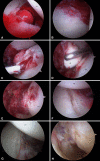Is posterior hip instability associated with cam and pincer deformity?
- PMID: 22879091
- PMCID: PMC3492598
- DOI: 10.1007/s11999-012-2468-3
Is posterior hip instability associated with cam and pincer deformity?
Abstract
Background: Posterior hip instability is an increasingly recognized injury in athletes; however, the function of patients after these injuries and an understanding of the pathoanatomy and underlying mechanism are currently unclear.
Questions/purposes: We determined (1) the function of patients after these hip injuries using validated, self-reported outcome instruments and (2) the specific pathoanatomy sustained in these events to better understand the mechanism of posterior hip instability.
Methods: We reviewed the records of all 22 athletes presenting to our clinics with a posterior acetabular rim fracture confirming a posterior hip instability episode. Radiograph, CT, and MRI findings were documented in all patients. Intraoperative findings were recorded in patients undergoing surgery. There were 19 males and three females with an average age of 22 years (range, 13-31 years). Minimum followup was 2 years (average, 4 years; range, 2-16 years).
Results: The mean modified Harris hip score was 94, Hip Outcome Scores for Activities of Daily Living and Sport were 99 and 87, respectively, and 20 of 22 athletes returned to sport. The most common constellation of pathoanatomy was a posterior labral tear with rim fracture, anterior labral tear, capsular tear, ligamentum teres avulsion, and chondral injury of the femoral head with loose bodies. Sixteen of the 18 patients with femoroacetabular impingement (FAI) had a twisting or noncontact mechanism of injury.
Conclusions: When posterior hip subluxation is recognized and avascular necrosis avoided, these athletes generally have high functional outcome scores and high rates of return to sport. There is an apparent association between the occurrence of posterior hip instability and the presence of structural abnormalities often associated with FAI, which may contribute to a mechanism of FAI-induced posterior subluxation.
Level of evidence: Level IV, therapeutic study. See the Instructions for Authors for a complete description of levels of evidence.
Figures





References
MeSH terms
LinkOut - more resources
Full Text Sources
Medical
Research Materials

